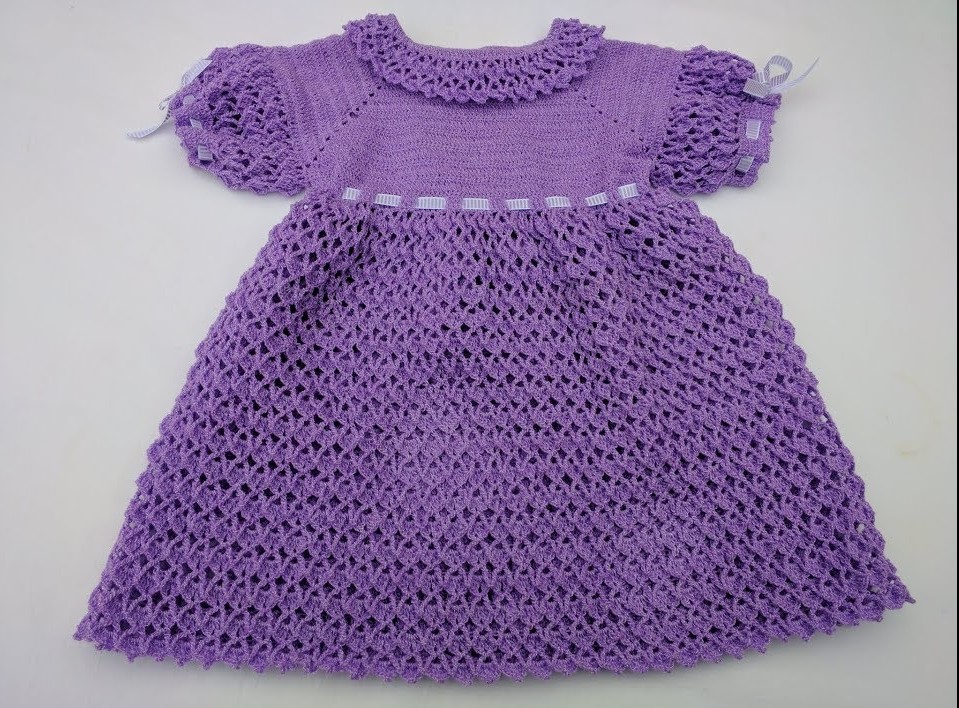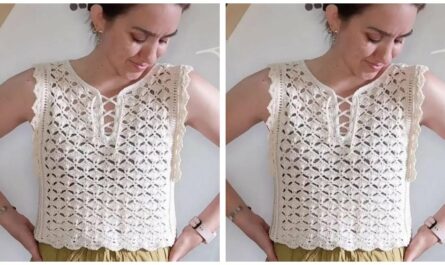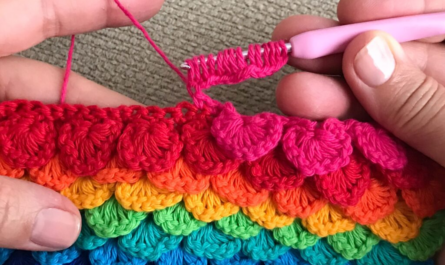There’s a special kind of magic in creating something beautiful with your own hands, especially for a little one. A Lilac Crochet Dress for Girls perfectly encapsulates this enchantment – blending the delicate charm of a beloved pastel with the warmth and artistry of handmade stitches. Lilac, a color often associated with spring blooms, innocence, and fairy tales, transforms a simple dress into a garment fit for a princess, a playful adventurer, or a cherished everyday outfit.
This detailed article will delve into the joys and practicalities of crocheting a dreamy lilac dress for the special girls in your life, covering design considerations, essential techniques, and tips to ensure comfort and lasting memories.
The Enchanting Appeal of a Lilac Crochet Dress for Girls

- Color Psychology: Lilac is a soft, gentle, and calming shade of purple. It evokes feelings of innocence, imagination, and whimsy, making it a perfect choice for children’s wear. It’s subtle yet captivating.
- Versatile Charm: A lilac crochet dress can be dressed up for special occasions like birthdays, parties, or photo shoots, or kept simple for comfortable, charming everyday wear.
- Handmade with Love: A crocheted dress is a deeply personal and unique gift. It’s a tangible expression of affection and effort, creating a cherished keepsake.
- Comfort & Playability: Unlike some stiff fabrics, a well-chosen yarn and stitch pattern can make a crochet dress incredibly soft, breathable, and comfortable for active play.
- Timeless Whimsy: The classic combination of a dress and a gentle, inviting color like lilac ensures this garment will never go out of style, making it a beloved piece for years or even generations.
Designing a Little Dream: Key Considerations
Creating a dress for a girl means balancing aesthetics with practicality:
- Shade of Lilac:
- Pale Lavender: Very soft and ethereal, ideal for newborns or delicate designs.
- Medium Lilac: A vibrant yet gentle hue, widely popular and versatile.
- “Pinkish” Lilac: Leaning more towards a soft rose, adding warmth.
- “Bluish” Lilac/Periwinkle: A cooler tone, often very elegant.
- Consider how the shade will look against the girl’s skin tone and in different lighting.
- Complementary Colors (for accents):
- White or Cream: For classic, gentle contrast (collars, edgings, flower appliques).
- Pale Pink or Mint Green: For a multi-pastel, whimsical look.
- Silver or Gold: For a touch of sparkle (e.g., in a ribbon or a subtle thread in the yarn).
- Yellow: A soft lemon can add a cheerful pop.
- Yarn Choice (Paramount for Girls’ Wear):
- Fiber:
- Baby Acrylics: Often the top choice for children’s items. They are incredibly soft, durable, hypoallergenic, and machine washable.
- Cotton/Cotton Blends: Excellent for breathability, especially in warmer climates. They hold shape well and are also machine washable. Look for mercerized cotton for a slight sheen.
- Superwash Merino Wool: Offers superior softness and warmth, plus it’s machine washable, but can be more expensive.
- Durability & Washability: The dress must withstand frequent washing and the rigors of play. Always check the yarn label for care instructions.
- Weight: DK (Double Knitting, Category 3) is a popular choice for children’s dresses, offering a good balance of warmth and working speed. Sport (Category 2) or Fingering (Category 1) can create a more delicate, heirloom-quality piece.
- Fiber:
- Stitch Pattern:
- Balance: Choose patterns that are both pretty and durable. Avoid overly delicate lace that might snag easily during play.
- Delicate & Openwork: Shell stitches, fan stitches, V-stitches, or simple mesh patterns create beautiful texture and drape. If using very open patterns, consider adding a lining (see below).
- Textured & Whimsical: Puff stitches, bobbles, or cluster stitches can add delightful dimension and a playful, “bubbly” feel.
- Solid Stitches: Single Crochet (SC), Half Double Crochet (HDC), or Double Crochet (DC) can form a sturdy base, with texture added through stitch placement or simple repeats.
- Silhouette & Fit:
- A-line: Classic and universally flattering, allowing for easy movement and a lovely “twirl” factor.
- Empire Waist: Fitted bodice with a skirt that flows from just below the chest, comfortable and often very pretty.
- Simple Shift: A straight, relaxed fit that skims the body, allowing for growth.
- Comfort for Movement: Ensure ample ease around the chest, waist, and hips for comfortable play.
- Room for Growth: Many patterns incorporate some room or are designed to be worn for multiple sizes.
- Embellishments & Details:
- Ribbons: Woven through openwork, used as a sash, or tied into bows on shoulders.
- Crocheted Flowers: Small rosettes or simple floral appliques sewn onto the bodice or skirt.
- Buttons: For back closures, choose larger, securely sewn buttons for safety.
- Picot Edging: A delicate finish around necklines, sleeves, or the hem.
- Safety: For very young children, avoid small beads or anything that could be a choking hazard.
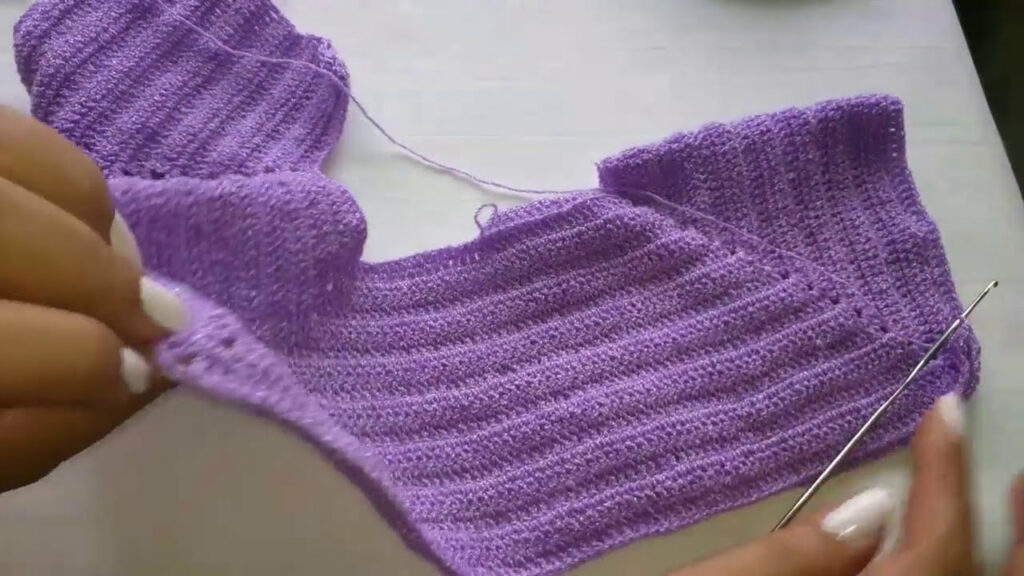
Materials: Your Kit for Little Wonders
- Yarn: Your chosen lilac shade(s) and any accent colors. Consult your pattern for recommended yardage based on size.
- Crochet Hooks: The size(s) recommended by your pattern to achieve the correct gauge and fabric density.
- Stitch Markers: Indispensable for marking rounds, shaping, and specific stitch counts, especially in garment construction.
- Tapestry Needle (or Blunt Yarn Needle): Crucial for weaving in ends neatly and for seaming.
- Scissors.
- Measuring Tape: Essential for detailed body measurements, gauge swatching, and checking garment dimensions as you go.
- Optional:
- Buttons (ensure they are securely sewn and appropriately sized for safety).
- Ribbons, fabric for lining (if the pattern is very open or for modesty).
Essential Crochet Techniques for a Girl’s Dress
Crafting a dress involves a range of skills:
- Foundation Chain / Foundation Single Crochet (FSCs): For a flexible and neat starting edge, especially important for necklines.
- Basic Stitches: Chain (ch), Slip Stitch (sl st), Single Crochet (sc), Half Double Crochet (hdc), Double Crochet (dc) – the building blocks.
- Working in Rounds vs. Rows: Most dresses for girls are worked seamlessly in the round for the body, with some elements (like back openings or specific shaping) worked in rows.
- Garment Shaping:
- Yoke Shaping: Creating the upper part of the dress, often with increases to shape shoulders and neckline.
- Waist / Bodice Shaping: Increases or decreases to create the desired silhouette from the yoke to the skirt.
- Armhole & Neckline Shaping: Creating smooth, even openings.
- Lace / Openwork (if desired): Mastering your chosen pattern for consistency.
- Edging / Borders: Creating neat and decorative finishes for hems, sleeves, and necklines.
- Buttonholes (if applicable): Learning to create neat, functional buttonholes within your crochet fabric.
- Blocking: This transforms the crochet fabric, evens out stitches, enhances drape, and sets the final shape and dimensions of the dress. It’s crucial for a professional finish.
Planning the Perfect Fit: Laying the Foundation
- Sizing & Measurements:
- While patterns often provide age-based sizing, it’s best to take specific measurements of the child: chest circumference, shoulder-to-hem length, and arm circumference (if sleeves).
- Consider the desired ease (extra room) for comfort and movement, and whether you want room for growth.
- Gauge Swatch (Non-Negotiable!):
- Crochet a substantial swatch (at least 4×4 inches / 10×10 cm) in your main stitch pattern with your chosen yarn and hook.
- Wash and block your swatch exactly as you plan to wash and block the finished dress. This is absolutely vital for ensuring the dress comes out the correct size.
- Measure your stitches and rows per inch/cm accurately. Adjust your hook size if your gauge doesn’t match the pattern’s.
- Yarn Quantity: Consult your chosen pattern’s yardage requirements for the specific size you are making. It’s always wise to buy a little extra.
- Pattern Selection: Choose a well-written pattern specifically for a girl’s crochet dress. Look for clear instructions, sizing options, and helpful diagrams. Many excellent patterns are available online (e.g., Ravelry, designer blogs).
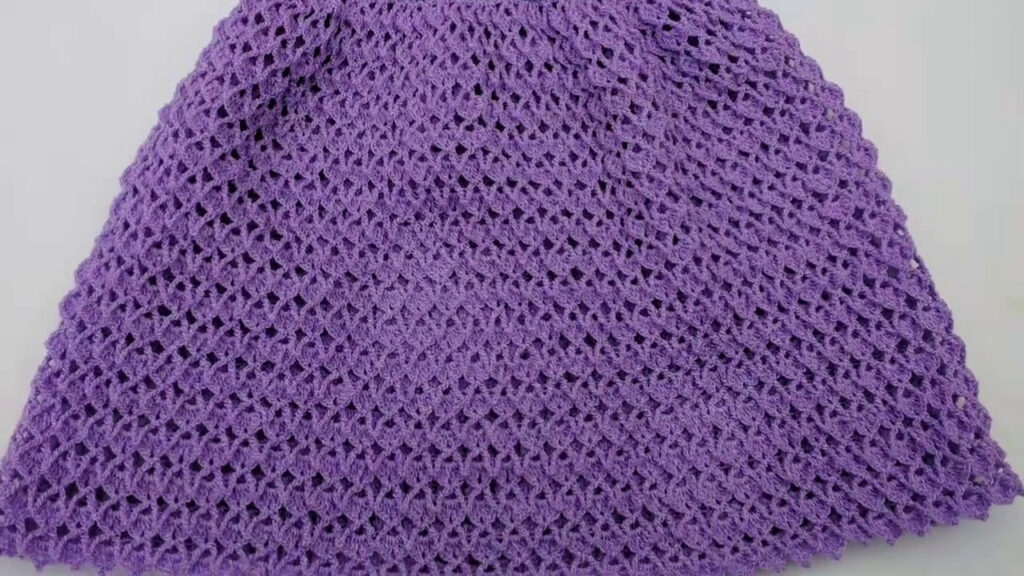
Construction Journey: Weaving Tiny Dreams into Fabric (Conceptual Guides)
- Yoke / Bodice First (often top-down): Many girls’ dresses are worked top-down, starting with the neckline and shaping the yoke with increases. This allows you to try on the dress as you go and adjust length easily.
- Skirt Attachment: Once the yoke/bodice is complete and armholes are separated, the body of the dress is usually joined in the round.
- Skirt Shaping: Increase stitches as you work down the skirt to create an A-line shape or simply let the stitch pattern create a natural flare for “twirl” potential.
- Sleeves / Armholes: Finish armholes with a neat edging for sleeveless designs, or attach/work sleeves directly from the armhole openings.
- Neckline & Back Opening: Pay attention to how the neckline is shaped and finished. If there’s a back opening, ensure it’s neat and secure with buttons or ties.
- Finishing Edges: Complete all cuffs, hems, and the neckline with your chosen decorative or simple border.
Finishing Touches: A Sprinkle of Pixie Dust
- Weaving in All Ends: Meticulously weave in every single yarn tail. For children’s wear, neat and secure weaving is crucial for comfort and durability.
- Attaching Buttons / Ribbons: If your dress has buttons, securely sew them on. Weave ribbons through eyelets or attach bows.
- Blocking: Gently wet your finished dress (or steam it). Carefully lay it out flat on blocking mats, shaping it precisely to its intended dimensions. Allow to dry completely. Blocking makes stitches even, opens up lace, and sets the final beautiful drape of the dress.
- Lining (if openwork): If your chosen stitch pattern is very open, consider a simple cotton slip dress or sewing a fabric lining inside for modesty and comfort.
Styling a Little Lilac Beauty
A lilac crochet dress is versatile:
- For Everyday: Pair with simple sandals or sneakers for a comfortable, charming look.
- For Parties: Add pretty ballet flats, a matching hair bow, and maybe a little sparkle.
- For Photoshoots: Its soft color and texture are perfect for creating dreamy, ethereal images.
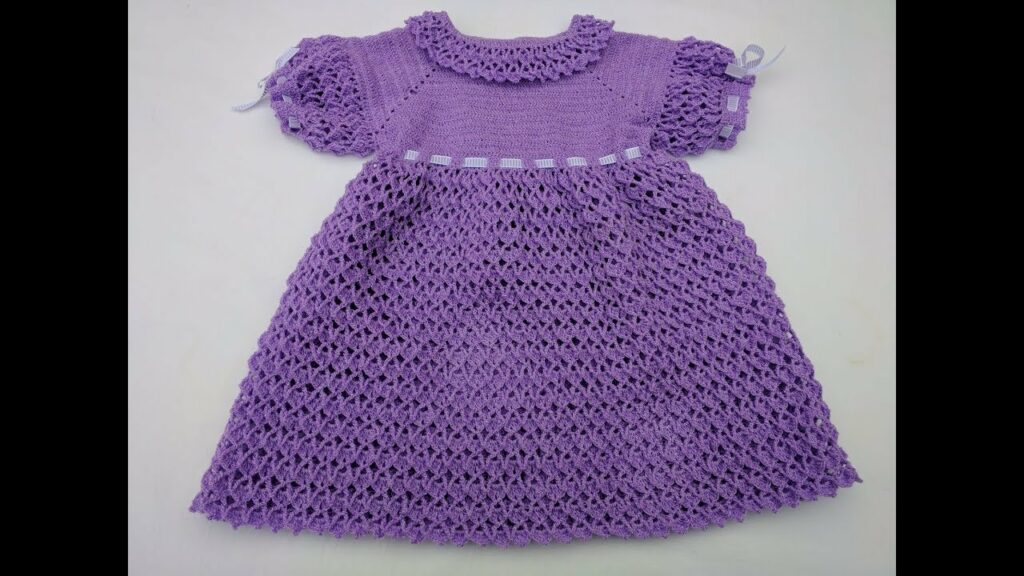
Tips for Success
- Soft, Washable Yarn is Key: Prioritize comfort and easy care for busy parents.
- Gauge, Gauge, Gauge! It’s the only way to ensure your finished dress matches the pattern’s size.
- Prioritize Comfort: Avoid scratchy fibers or bulky seams that might irritate a child’s delicate skin.
- Allow for Growth: Many patterns are designed with some built-in ease, but consider sizing up if the child is between sizes.
- Secure All Embellishments: Ensure buttons, appliques, or any other additions are sewn on very securely, especially for younger children.
- Embrace the Whimsy: Let the magic of the color inspire your stitch choices and embellishments!
Caring for Your Handmade Treasure
- Follow Yarn Label Instructions: Always refer to your specific yarn’s care guidelines for washing and drying.
- Gentle Machine Wash (if applicable) or Hand Wash: Most acrylics and cottons can be machine washed on a gentle cycle. For delicate items, hand washing in cool water with a mild detergent is safest.
- Reshape and Lay Flat to Dry: Never hang a wet crocheted dress, as this will cause stretching and distortion. Gently squeeze out excess water (rolling in a clean towel helps), reshape the dress to its original dimensions, and lay it flat on a clean towel or a mesh drying rack to air dry completely.
Video Tutorial ;
Crocheting a lilac dress for a girl is more than just a craft project; it’s an act of love, creating a cherished garment that will bring joy and beautiful memories for years to come. Sources
